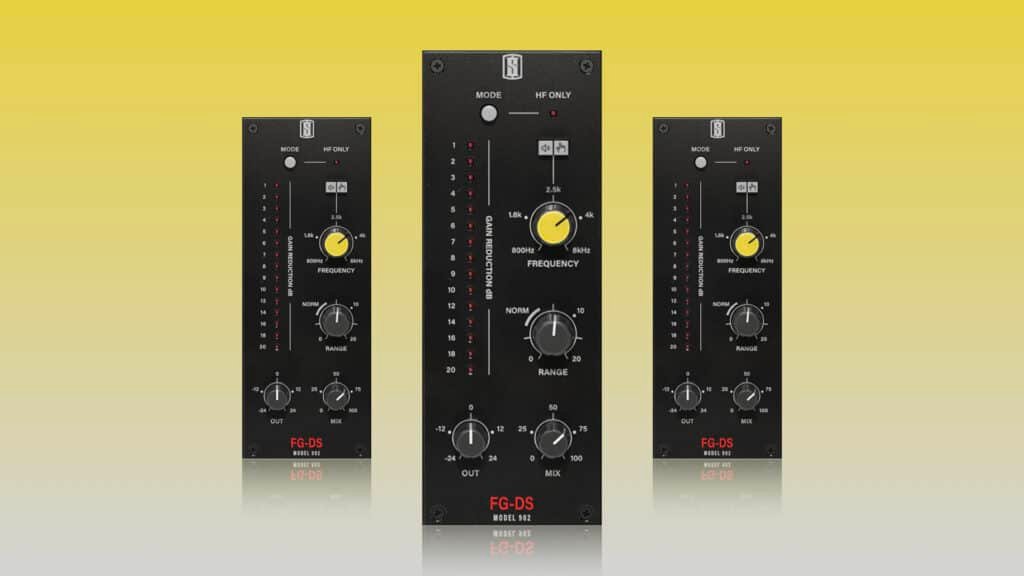On June 14, 2022, the great plugins and audio hardware manufacturer Slate Digital released a new module for its very famous Virtual Mix Rack: FG-DS 902. Being a member of All Access Pass, I had direct access to it and could test it on some projects. Here is what I think about it!

FG-DS 902 is a de-esser produced as a module of the Virtual Mix Rack from Slate Digital. It is the first de-esser to be released as a module. It is thus a great first for the Steven Slate’s American company.
Need a professional sound engineer specializing in pop and hip-hop mixing ? Great! Take a look at our services and let’s blow up your career together!
Let’s start now!
First Impressions
A de-esser in the Virtual Mix Rack, finally! This is what many users of this multi-functional plugin have been waiting for for several years.
Now it’s done. With this new de-esser, the Virtual Mix Rack asserts itself as an advanced and ultra-versatile plugin that can be used on all types of sources: vocals, guitars, drums, basses,…
But before installing and activating it in my DAW, my first question was the following: Is this FG-DS 902 up to the standard of other modules?
Well, first of all, you should know that most of the Virtual Mix Rack modules are emulations of legendary audio hardware (if you’re a VMR user, you probably already know this). The sound result of each module being generally close to the original piece, the quality of this plugin is undeniable.
But in this case, one important element made me doubt before trying it: the emulated piece is the dbx 902. Despite all the respect I have for the dbx brand, the American company is far from the premium quality offered by other brands like Universal Audio, Teletronix, Emoirical Labs, and many others…

So is this emulation up to par with all its neighbors? Will the FG-DS 902 not be the bad pupil of this luxurious tool that is the Virtual Mix Rack? We’ll see in the rest of this article.
Overview
As with all Virtual Mix Rack modules, the FG-DS 902 follows the vertical format and is very close to the design of the original unit.
In terms of knobs, this module seems to be more complete than the original dbx unit. Let’s have a look at what’s inside.

The first thing that catches the eye is the red LED line that shows the gain reduction in dB. This is already, in my opinion, a big strength for the FG-DS 902, because it allows to have an idea of the intensity of the correction, and simply not to miss!
At the top of the plugin, true to the original, a HF only switch. Very useful when the sibilance is very localized in the frequency spectrum (or not!).
Just below this switch is an element that is increasingly the strength of digital compared to analog: a listening mode. This mode allows to listen only to the signal processed by the module. This is the kind of feature that allows you to find the critical frequency zone faster and more efficiently.
Below, on the right, are two of the most important knobs of this FG-DS 902:
- A frequency knob, which allows you to adjust the frequency range on which the module should focus to process sibilance.
- A range knob, which allows the user to determine how much the de-esser should reduce critical frequencies.
At the bottom of the plugin there are two last knobs. One (the Out knob) will allow you to adjust the output level. And the other one (the Mix knob) which will allow to balance the signal processed by the FG-DS 902 and the original unprocessed signal.
Audio testing
There’s no point in talking about a plugin if there’s no audio illustration of its contribution to your mixes. To illustrate the sound result of this plugin, I decided to proceed as follows:
For each audio clip, you will first hear in 1, the audio source not processed by the FG-DS 902. This first clip still has, for the listening comfort, some basic processing (EQ, light compressor, auto-tune if needed,…). In 2, you will hear this same clip but with the Slate Digital de-esser activated and adjusted for the best possible rendering.
I chose very different voices for each example to have the widest vision of this de-esser. I advise you to have a reliable listening device to get started.
Test 1: Female Pop Vocals
Unprocessed
Processed
Have we lost some clarity? That’s the impression I get on the very first notes, don’t you?
In fact, I wanted to test these vocals first because it has a lot of air in the high end (above 12kHz). I think this is a good test for a de-esser. Honestly, I’m a bit disappointed, but I’m still happy with the final result.
Test 2: Male Pop Vocals
Unprocessed
Processed
Sibilance in men and women is completely different. That’s why I thought it was interesting to do the test on male pop vocals.
On these vocals, I love the result! The very aggressive “sss” on “see” is superbly controlled and all the rest of the sibilances are too and without artifact. I still feel a slight loss in the air zone but not as obvious as in the first clip.
Test 3: Male rap Vocals
Unprocessed
Processed
Many of you are probably interested to hear the result on rap vocals. Also, the interesting thing about rap is that the sibilance often comes out a bit more because many rappers push the consonants.
Knowing the very bright mic this rapper used, I think the sibilance in this clip is pretty well controlled. I am satisfied!
Review
One thing is for sure: This FG-DS 902 is a very good plugin. If you are looking for a de-esser that can handle all kinds of vocals without degrading the overall quality of your signal, this Virtual Mix Rack module is the one to go for.
It has a lot of positive points that I will list below, but also some negative points that should not be overlooked when making a potential purchase or activation.
✅ PROS ✅
✅ The simple fact that this FG-DS 902 is a new module of the Virtual Mix Rack already earns points for this new tool. For regular VMR users, this de-esser completes a plugin that becomes a potential high quality channel strip on its own (if used correctly, of course!).
✅ This tool is intuitive and super easy to use, unlike many ultra complex de-essers on the market.
✅ The Mix knob is super convenient for precision work. Allowing the user to mix processed and unprocessed vocals is a brilliant idea that will surely ease the task of many producers and sound engineers.
✅ The FG-DS processes the source quite transparently and without artifacts.
❌ CONS ❌
❌ FG-DS produces a kind of analog tone on the whole signal which damages the top of the spectrum and the air zone
❌ No Band Pass filter available. This would have been a big plus for a more accurate work.
Need a professional sound engineer specializing in pop and hip-hop mixing ? Great! Take a look at our services and let’s blow up your career together!
Let’s start now!
Conclusion and final thoughts
Overall, FG-DS 902 is a very good plugin for high quality de-essing. The processing is clean, easy, intuitive and artifact-free and allows for precise dynamic control over sibilance.
In fact, for regular Virtual Mix Rack users, this is a dream come true: the vocal chain is finally completed within the Virtual Mix Rack exclusively. What a luxury!
But because of its too obvious tone and its little lack of precision, I would not use it in mixing as a priority. It can however be a perfect tool for vocal recordings.
So it is in my humble opinion not the greatest success for the American manufacturer. But I have no doubt that Slate Digital still has many surprises in store for its next plugins. And I don’t know about you, but I’m already looking forward to the next one!
If you have any questions about FG-DS or about anything in the field of mixing, contact me, I’m always very happy to help!
Related Articles:
My favorite tools for mixing pop and hip-hop music:
Plugins
In the field of auto-tune, I’m convinced that nothing’s better and more efficient than Antares Auto-Tune Pro. As for the EQ’s, FabFilter Pro-Q3 and Slate Digital Infinity EQ are, in my opinion, the best tools. For compression, I have 2 favorites plugins: Waves RComp and UAD EL8 Distressor.
As for reverb, I’m a big fan of the Soundtoys Little Plate, but generally, I go for the Valhalla VintageVerb for its versatility. I also love the Arturia Rev PLATE-140 and the UAD Pure Plate for its organic side.
Headphones
The closed headphones I love and will always love using for mixing pop and hip-hop music are the Beyerdynamic DT-770. As for the best open-back headphones, I use the Sennheiser HD600 headphones, and I’m really happy of them!
Monitors
Having a pair of Yamaha HS7 in its studio or home studio is always cool for more excitement while listening to your mixes. The Adam Audio T7V monitors are also super accurate. In my studio, I also have a pair of Genelec 8030 for their reliability.
Hardware gear
For anyone who wants to start using hardware in their mixes, I always recommend these 2 units from Klark Teknik: the EQP-KT and the 76-KT. Don’t forget to use good converters, such as the Apollo interfaces. This is essential for a good rendering.






